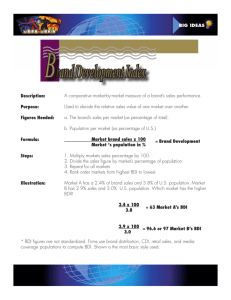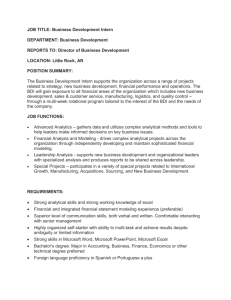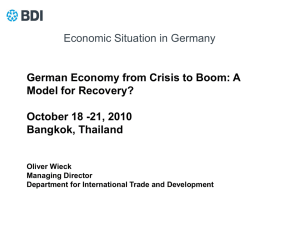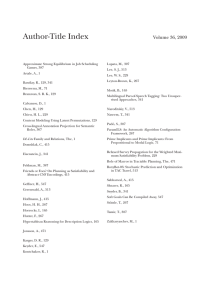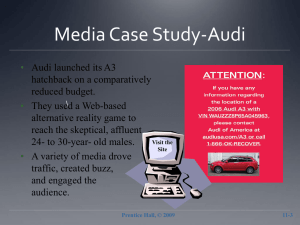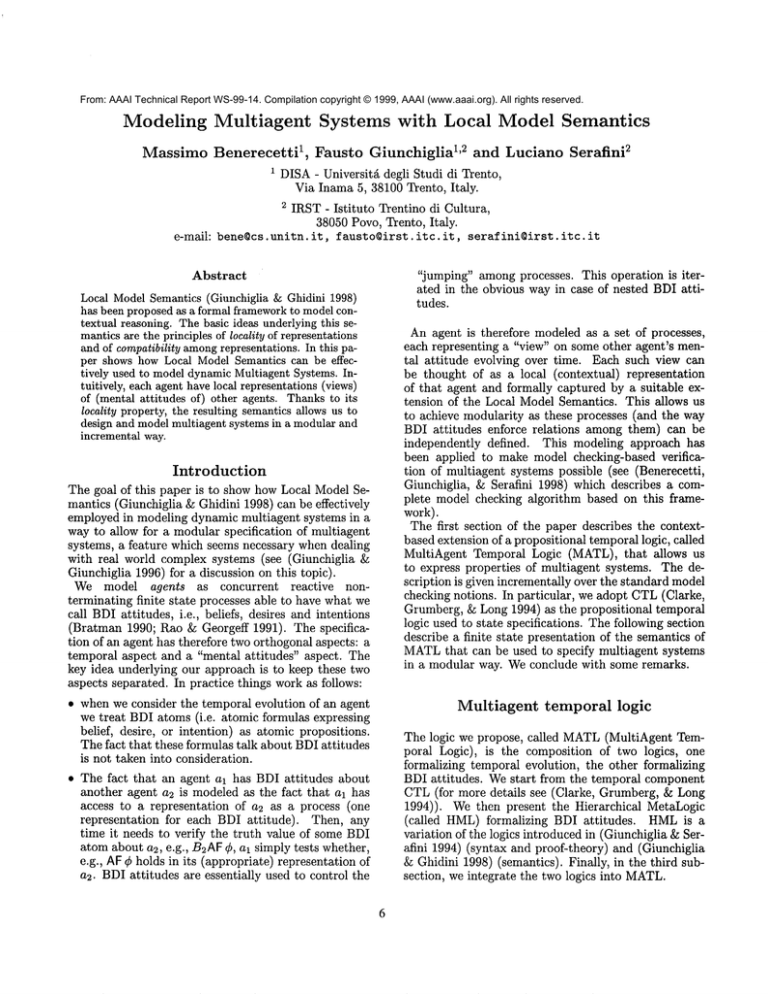
From: AAAI Technical Report WS-99-14. Compilation copyright © 1999, AAAI (www.aaai.org). All rights reserved.
Modeling Multiagent
Massimo
Benerecetti
1,
Systems with Local Model Semantics
Fausto
Giunchiglia
1’2
2and Luciano
Serafini
1 DISA- Universit£ degli Studi di Trento,
Via Inama 5, 38100 Trento, Italy.
2 IRST - Istituto Trentino di Cultura,
38050 Povo, Trento, Italy.
e-maihbene©cs.unitn.it, fausto©irst,
itc.it, serafini©irst,
itc.it
Abstract
Local Model Semantics (Giunchiglia &Ghidini 1998)
has been proposed as a formal frameworkto modelcontextual reasoning. The basic ideas underlying this semanticsare the principles of locality of representations
andof compatibility amongrepresentations. In this paper shows how Local Model Semantics can be effectively used to model dynamicMultiagent Systems. Intuitively, each agent have local representations (views)
of (mental attitudes of) other agents. Thanks to its
locality property, the resulting semantics allows us to
design and modelmultiagent systems in a modularand
incremental way.
Introduction
The goal of this paper is to show how Local Model Semantics (Giunchiglia & Ghidini 1998) can be effectively
employed in modeling dynamic multiagent systems in a
way to allow for a modular specification of multiagent
systems, a feature which seems necessary when dealing
with real world complex systems (see (Giunchiglia
Giunchiglia 1996) for a discussion on this topic).
We model agents as concurrent
reactive
nonterminating finite state processes able to have what we
call BDIattitudes, i.e., beliefs, desires and intentions
(Bratman 1990; Rao & Georgeff 1991). The specification of an agent has therefore two orthogonal aspects: a
temporal aspect and a "mental attitudes" aspect. The
key idea underlying our approach is to keep these two
aspects separated. In practice things work as follows:
¯ when we consider the temporal evolution of an agent
we treat BDI atoms (i.e. atomic formulas expressing
belief, desire, or intention) as atomic propositions.
The fact that these formulas talk about BDI attitudes
is not taken into consideration.
¯ The fact that an agent al has BDI attitudes about
another agent a2 is modeled as the fact that al has
access to a representation of a2 as a process (one
representation
for each BDI attitude).
Then, any
time it needs to verify the truth value of some BDI
atom about a2, e.g., B2AF¢, al simply tests whether,
e.g., AF¢ holds in its (appropriate) representation
a2. BDIattitudes are essentially used to control the
"jumping" among processes. This operation is iterated in the obvious way in case of nested BDI attitudes.
An agent is therefore modeled as a set of processes,
each representing a "view" on some other agent’s mental attitude evolving over time. Each such view can
be thought of as a local (contextual) representation
of that agent and formally captured by a suitable extension of the Local Model Semantics. This allows us
to achieve modularity as these processes (and the way
BDI attitudes enforce relations among them) can be
independently defined. This modeling approach has
been applied to make model checking-based verification of multiagent systems possible (see (Benerecetti,
Giunchiglia, & Serafini 1998) which describes a complete model checking algorithm based on this framework).
The first section of the paper describes the contextbased extension of a propositional temporal logic, called
MultiAgent Temporal Logic (MATL), that allows
to express properties of multiagent systems. The description is given incrementally over the standard model
checking notions. In particular, we adopt CTL(Clarke,
Grumberg, & Long 1994) as the propositional temporal
logic used to state specifications. The following section
describe a finite state presentation of the semantics of
MATL
that can be used to specify multiagent systems
in a modular way. Weconclude with some remarks.
Multiagent
temporal
logic
The logic we propose, called MATL(MultiAgent Temporal Logic), is the composition of two logics, one
formalizing temporal evolution, the other formalizing
BDI attitudes.
Westart from the temporal component
CTL(for more details see (Clarke, Grumberg, & Long
1994)). We then present the Hierarchical MetaLogic
(called HML)formalizing BDI attitudes.
HMLis
variation of the logics introduced in (Giunchiglia & Serafini 1994) (syntax and proof-theory) and (Giunchiglia
&Ghidini 1998) (semantics). Finally, in the third subsection, we integrate the two logics into MATL.
CTL
CTLis a branching time propositional temporal logic.
Let us consider in turn the language and semantics.
Language. Given a set P of propositional atoms, the
set of CTLformulas ¢ is defined inductively as follows:
¢,¢ ::=pl
~¢ I ¢^¢ I EX¢ I A(CU¢) I E(¢
where p E P. Wehave the following intuitive meanings:
KX¢ meansthat there is a path such that ¢ will be true
in the next step; A (¢ L/¢) means that ¢ will be true
a state in the future and that ¢ will be true in all the
states before, for all paths; E (¢ U¢) means that there
exists a path such that ¢ will be true in a state in the
future and that ¢ will be true in all the states before.
The following abbreviations are used:
¢ D ¢ dej _~(¢A_~¢)
EF¢ d~j E(TU¢)
EG¢ clef
= -~A (T Z,/~¢)
AF¢ dej A (T U¢)
AGedej-~E(TZ,(-~¢)
AX¢ aef
= ~EX--,¢
Semantics. The semantics for CTL formulas is the
standard branching-time temporal semantics based on
Kripke-structures.
A CTL structure is a tuple m =
S,
/ so, R, L), whereS is a set states, so E S is the initial
state, R is a total binary relation on S, and L : S --4
7~(P) is la beling fu nction, which as sociates to each
state s E S the set L(s) of propositional atoms true
at s. A path x in m is an infinite sequence of states
Sl,S2,... such that for every i _> 1, siRsi+l.
Satisfiability
of a formula ¢ in a CTLstructure m at
a state s is defined as follows:
¯ m,s~:pif[pEL(s);
¯ m,s~ -~¢iffm,
s V= ¢;
¯ m,s~¢A¢iffm,
¯ m,s ~ EX¢ iff
s~¢andm,
s~¢;
~
there’s a s with sRs ~, such that
m, s’ ¢;
¯ m,s ~ A(¢//¢)
iff for every path x = (s
sl,s2,...)
there’s a k > 1 such that m, sk ~ ¢ and,
for everyl<j <k,m, sj ~ ¢;
¯ m,s ~ E(¢LI¢) iff there’s
a path x = (s
Sl,S2,...)
and a k > 1 such that m, sk ~ ¢ and
for everyl<j<k,m,
sj ~ ¢.
¯ m~¢iffm,
so~¢.
HML
Let us consider in turn the language(s) and the semantics.
Language(s). Suppose we are modeling a situation
with a set I of agents. Each agent has its own beliefs, desires, and intentions about itself and the other
agents. Let us adopt the standard notation to express
attitudes. Bi, Di, and Ii, for any i E I, are called BDI
operators for agent i (or simply BDI operators).
denotes any BDI operator for agent i. Bi¢ (Die, Ii¢)
means that agent i believes (desires or intends) ¢. Let
O = {n, D, ~} be a set of symbols, one for each BDIattitude. Let OI* be the set ( O x I)*, i.e., the set of finite
(possibly empty) strings of the form olil ... o,in with
ok E O and ik E I. Wecall any a E OI*, a view. Intuitively, each view in OI* represents a possible nesting
of BDIattitudes. Wealso allow for the emptystring, e.
The intuition is that e represents the view of an external
observer which, from the outside, "sees" the behavior of
the overall multiagent system. Depending on the goals,
the external observer can represent the person designing the system, or a selected process of the multiagent
system which is given this privileged status. Figure 1
shows pert of the tree of views for a multiagent system
with two agents s and r.
It is important to notice that the crucial notion is that
of view. An agent, e.g., i, is thus represented by three
trees rooted in the views that the external observer has
of i’s beliefs, desires and intentions respectively (e.g.
the views Bi, Di and li). Notice also that the view that
an agent has of another agent is in general different from
the agent itself. This allows us for instance to modelthe
fact that agent i might have false beliefs about agent j.
We associate a logical language /:~ to each view
a E OI*. Intuitively,
each £a is the language used
to express what is true (and false) in the representation corresponding to a. In particular, the language £~
is used to speak about the whole multiagent system.
Thus, intuitively, a formula p A Bi-~p E /:~, (denoted
by e : p A Bi-~p) means that p is true and that agent i
believes that p is false. The languages /:si £Di, and
£//are the languages that i adopts to represent its beliefs, desires and intentions, respectively. The language
~,BiIj
is used to specify i’s beliefs about j’s intentions,
and so on. Intuitively, the formula pA Bi-~p E £Dj (denoted by Dj : p A Bi-,q) means that agent j desires two
things: that p is true and that agent i believes that p
is false.
Notice that we do not put any restriction on the languages £a, except that Oi¢ must be an atomic formula of £~ if and only if ¢ is a formula of £aoi (see
(Giunchiglia & Giunchiglia 1996) for a study of how
this condition can be modified in order to capture various interesting properties). Weallow also for empty
languages. However/:~ cannot be empty as we need to
be able to talk about the whole multiagent system.
Semantics. We need to define the semantics of the
family of languages a {£~,}o,
eox.(hereafter we drop
the index a). To understand the semantics we need
to understand two key facts. On the one hand the semantics of formulas depend on the view. For instance~
the formula p at the view B/ expresses the fact that i
believes that p is true. The same formula in the view
sj expresses the fact that j believes that p is true. As
a consequence, the semantics associates locally to each
view a a set Maof interpretations of £a. On the other
hand there are formulas in different views which have
the same intended meaning. For instance Bjp in view
S/, and p in view BiBj both mean that i believes that
j believes that p is true. This implies that only certain
Figure 1: A tree of views.
subsets of interpretations of different views are compatible, and these are those which agree on the truth values
of the formulas with the same intended meaning. To
capture this notion of compatibility we introduce the
notion of chain.
Let a be any view, a a-chain c is a finite sequence
(ce,...,c~,...,ca>,
where c~ = m E M~is an interpretation for £:;~ and ~ is a prefix of a (i.e. a = ;37 for
some 7). A compatibility relation C on {La} is a set
of a-chains, for every a. Intuitively, C will contain
all those c’s whose elements ca, c~ (where a, ;3 are two
views in OI*) assign the same truth values to the formulas with the same intended meaning. (For a detailed
discussion about these intuitions and also for a technical presentation, see (Giunchiglia, Serafini, & Simpson
1992) and (Giunchiglia & Ghidini 1998).)
Let us now define the semantics of HML.Westart
with satisfiability local to views (first step) and suppose
that for each view a there is a satisfiability
relation
between Ma and formulas of £:a- With an abuse of
notation, we denote all these satisfiability relations with
the same symbol ~. The context always makes clear
which relation we mean. The second step is to define
(global) satisfiability taking into account chains. To
this we need some notation. Let ~ denote satisfiability
also for chains.
For any a-chain c and for any formula in £:~, satisfiability relation ~ is defined only wheneither a is a prefix
of ;3 or ;3 is a prefix of a. (i.e. wheneither a = ;3T or
;3 = aT). If a = ;3T then c~ ~ ¢ iff ¢ is true in c~. If
;3 = aT then c;9 ~ ¢ for any ¢.
Let us extend the satisfiability relation to sets of formulas: x ~ Y if and only if for any y E Y, x ~ y.
Weare now ready to define the notion of model for
HML(called HMstructure), and then that of satisfiability between HMstructures and formulas of a view.
Definition
1 (HM structure)
A nonempty compatibility relation C on {~:a) is a Hierarchical MetaStructure (HMstructure) on {Ca} if given any a;3-chain
c E C, ca ~ Oi¢ if/for every aT-chain c I E C, c!a = ca
implies Cao~~ ¢.
The intuitions underlying Definition 1 are described
in detail in (Giunchiglia & Ghidini 1998). Briefly: the
nonemptyness condition for C guarantees that the external observer has a consistent view of the world; the
only if part in the definition guarantees that each view
has correct BDI attitudes, i.e. any time O1¢ holds at
a view then ¢ holds in the view one level down in the
chain; the if part is the dual property and ensures the
completeness of each view.
Given an HMstructure C, a formula ¢ and a view a,
C ~ a : ¢ is read as ¢ is true in C (or equivalently,
holds in C, or ¢ is satisfied by C) at view a, and it is
defined as follows:
C ~ a : ¢ iff for all a;3-chain c E C, ca ~ ¢ (1)
The intuition is that in order to check the satisfiability
of ¢ at the view a we need to check all the interpretations of £:a allowed by the compatibility imposed by
the chains we are considering.
MATL
Let us consider in turn the language(s) and the semantics.
Language(s).
We define MATLas a kind of HML
where each language £:~ is a CTLlanguage. We want
to allow for (agents and) views with different languages.
Let {Pa} be a family of sets of propositional atoms.
Each Pa allows for the definition of a different language (also called an MATL
language (on {Pa})). Since
(agents and) views have BDI attitudes, we need to extend the propositional atoms of each MATLwith the
appropriate BDI atoms. Therefore, the family of MATL
languages on {Pa} is the family of CTLlanguages {/:a}
where £:a is the smallest CTLlanguage containing the
set of propositional atoms Pa and the BDI atoms 0i¢
for any £aoi formula ¢.
Semantics. The semantics for a family of MATLlan:
guages is defined in terms of HMstructures, where the
semantics local to each view is a set of CTLstructures.
Given a CTLstructure m = (S, so, R, L) and a state
s of m, let m[s/so] be the CTLstructure (S, so,R,L)
obtained by replacing the initial state so of mby s.
Definition
2 (MATLstructure)
A MATLstructure
on {Pa} is an HMstructure C for a family of MATL
languages on {Pa}, such that for any a;3-chain c E C,
if the CTLstructure ca = m, then for any state s of m,
there is a at3-chain c’ 6 C such that c!a = m[s/so].
A MATLstructure
is a particular
kind of HM
structure. 1 Therefore it keeps the same notion of satisfiability given by (1).
Satisfiability
in a MATL
structure can be understood
on the basis of two crucial observations, concerning the
mutual nesting of CTLoperators and BDI operators.
The first, concerning the nesting of CTLoperators inside BDI operators is that ca ~ ¢ is computed using
the notion of satisfiability
in a CTLstructure. Therefore, a chain links the fact that a BDI atom holds in
the initial state of a CTLstructure in one view with
the fact that its argument holds in the initial state of
a CTL structure in the view below. The second observation concerns the nesting of BDI operators inside
temporal operators. (Temporal operators which involve
no BDI atoms are treated as in CTLstructures, that is,
without jumping among views). Consider for instance
the formula EX Bip. To assess the truth of EXBip we
need to be able to assess the truth of Bip in some future state s of the CTLstructure we are considering,
e.g., m = (S, so,R,L). The only way to establish this
is to request that in s we have a chain d which gives
access to a CTL structure in the view below. Given
the fact that chains connect CTLstructures only for
what holds in their initial state, the only solution is to
request that s is the initial state of a CTLstructure
d, = m’ = m[s/so] with c’ 6 C. Given the fact that
temporal operators allow us to state facts about all the
states in a CTLstructure, this operation must be repeated for each state s 6 S. But this is exactly what
Definition 2 says.
Multiagent finite
state machines
MATL
structures are in general infinite structures. In
fact, CTLstructures can have an infinite number of
states, and also a labeling function which maps to an
infinite number of atoms, while HMstructures can have
an infinite numberof chains (corresponding to an infinite compatibility relation), chains with infinite branching (corresponding to an infinite number of attitudes
per agent and/or an infinite number of agents) or infinitely long chains (corresponding to the case of unbounded nested BDI attitudes).
In many applications, like automatic model checkingbased verification of systems, we are interested in having a finite presentation of the semantics. For instance
in model checking one deals with finite CTLstructures,
i.e., CTLstructures whichhave a finite set of states, and
also a labeling function mapping to a finite number of
atoms. The crucial observation is that finite CTLstructures can be seen as finite state machines (FSMs),
1Each view of a MATLstructure contains many CTL
structures whichdiffer only for the initial state. This redundancyis admitted for the sake of simplicity. In Section
we show how these structures can be presented with only
one structure.
FSMbeing an object f = (S, so, R, L) (with everything
finite).
Our solution is to extend the notion of FSM
to that of MultiAgent Finite State Machine (MAFSM),
where, roughly speaking, a MAFSM
is a finite set of
FSMs.A first step in this direction is to restrict ourselves to finite HMstructures, i.e., those HMstructures
which have a finite number of chains, and a finite number of views (~ such that there is a a-chain (notice that
this limits both the number and the depth of chains).
Thus, let OIn denote a finite subset of OI* obtained by
taking the views in any finite subtree of OI* rooted at
view e. Howeverthis is not enough as finite HMstructures allow for an infinite number of BDI atoms. Even
if we have a finite numberof processes we cannot model
them as FSMs. Wesolve this problem by introducing
the notion of explicit BDI atom. Formally if {L:~} is a
family of MATL
languages, then Expl(oi, (~) is a (possibly empty) finite subset of the BDI atoms of/:~. The
elements of Expl(oi, a) are called explicit BDI atoms.
Wehave the following.
Definition 3 Let {f~} be a family of MATL languages on { P~}. A MultiAgent Finite State Machine
(MAFSM)
F = {F,~} for {/:,~} is a reeursive total function such that:
1. F~#O;
2. for all views a 60I n C 0I* (with OIn finite),
it associates a nonempty finite set Fa of FSMson
the MATL language on the following atoms: P~,
Expl(Bi, (~), Expl(Di, a) and Expl(xi, a), for
I;
3. for all views a 6 0I* \ OIn, F~ = @.
The first condition (dual to the condition £:~ # ~ imposed in Section, and to Condition 1 in Definition 1 of
HMstructure in Section ) is needed as otherwise there
is nothing we can reason about; the second allows us to
deal with finite chains, and the third allows us to deal
with finite sets of atoms.
Given the notion of MAFSM,
the next step is give a
notion of satisfiability
in a MAFSM.
Westart from the
notion of satisfiability
of CTLformulas in an FSMat
a state. This notion is defined as in CTLstructures.
This allows us to determine the satisfiability of all the
propositional and explicit BDI atoms (and all the formulas belonging to the corresponding MATL
language).
For these formulas we do not need to use the machinery
associated to BDI attitudes. However, this machinery
is needed in order to deal with the (infinite) number
of BDI atoms which are not memorized anywhere in
MAFSM.
Let the set of implicit BDI atoms of a view a, written
Impl(oi, a), be defined as the (infinite) subset of all
BDI atoms of ga which are not explicit BDI atoms,
i.e. Impl(oi, a) = {Oi¢ 6 L:a \ Expl(oi,(~)}.
Let
ArgExpl(oi, a, s) be defined as follows.
ArgExpl(oi, a, s)
{¢ 6 L:aoi I 0i¢ ¯ L(s) N Expl(oi,
Conclusion
Intuitively, ArgExpl(oi, (~, s) consists of all the formulas ¢ E /:~o~ such that the explicit BDI atom Oi¢ is
true in s. Restricted to s and to the explicit BDIatoms,
ArgExpl(oi, a, s) is the set of formulas which satisfies
Conditions 1 and 2 (of correctness and completeness)
in the definition of HM(and MATL)structure, Definition 1 in Section . At this point, to define the satisfiability in a MAFSM,
it is sufficient to use the fact
that we know how to compute ArgExpl(oi, a, s) (it is
sufficient to use CTLsatisfiability
and then to compare
the results of the relevant CTLstructures) and exploit
ArgExpl(oi,a, s) to compute the implicit BDI atoms
which satisfy the two conditions of correctness and completeness.
In this paper we have defined a logic for multiagent
systems based on Local Model semantics fro contextual reasoning. Wehave shown the specification logic
and the language for specifying finite state automata.
This modeling frameworkhas been used as a basis for a
model checking algorithm (Benerecetti, Giunchiglia,
Serafini 1998). The approach allows us to specify multiagent systems incrementally and to reuse, in principle,
technology and tools already developed in model checking as the problem of modeling and verifying multiagent
system specifications has been reduced to the problem
of modeling and verifying processes. In doing this, the
notion of context (view) plays a crucial role. It allows
us to view agents as collections of local representation
modeling beliefs, desires and intentions of other agents
connected among them by compatibility relations. The
intrinsic locality of this semantics allows us to design
and specify multiagent systems in a modular and incremental way.
Definition
4 (Satisfiability
in a MAFSM)Let F
be a MAFSM, a a view, f = (S, so,R,L) E F~
FSM, and s e S a state. Then, for any formula ¢ of
F.a, F, a, f, s ~ ¢ is defined as follows:
1. F, ~, f, s ~ p, where p is a propositional atom or an
explicit BDI atom: the same as FSMsatisfiability;
2. satisfiability
of propositional connectives and CTL
operators: the same as FSMsatisfiability;
References
Benerecetti, M.; Giunchiglia, F.; and Serafini, L. 1998.
Model Checking Multiagent Systems. Journal of Logic
and Computation, Special Issue on Computational
Logical Aspects of Multi-Agent Systems 8(3):401-423.
Bratman, M. E. 1990. Intention, plan and practical
reason. Harvard University Press.
Clarke, E.; Grumberg, O.; and Long, D. 1994. Model
Checking. In Proceedings of the International Summer
School on Deductive Program Design.
Giunchiglia, F., and Ghidini, C. 1998. Local Models Semantics, or Contextual Reasoning = Locality +
Compatibility. In Proceedings of the Sixth International Conference on Principles of Knowledge Representation and Reasoning (KR’98), 282-289. Trento:
Morgan Kaufmann. Short version presented at the
AAAIFall 1997 symposium on context in KR and NL.
Giunchiglia, E., and Giunchiglia, F. 1996. Ideal and
Real Belief about Belief. In Practical Reasoning, International Conference on Formal and Applied Practical
Reasoning, FAPR’96, number 1085 in Lecture Notes
in Artificial Intelligence, 261-275. Springer Verlag.
Giunchiglia, F., and Serafini, L. 1994. Multilanguage
hierarchical logics (or: how we can do without modal
logics). Artificial Intelligence 65:29-70.
Giunchiglia, F.; Serafini, L.; and Simpson, A. 1992. Hierarchical meta-logics: intuitions, proof theory and semantics. In Proc. of META-92,Workshop on Metaprogramming in Logic, number 649 in LNCS, 235-249.
Uppsala, Sweden: Springer Verlag.
Rao, A. S., and Georgeff, M. P. 1991. Modeling rational agents within a BDI architecture. In Alien, J.;
Fikes, R.; and Sandewall, E., eds., Proceedings of the
2nd International Conference on Principle of Knowledge Representation and Reasoning. Morgan Kaufmann Publishers.
3. /7, (~, f, s ~ Oi¢, where Oi¢ is an implicit BDI atom,
iff for all f’ e Faoi and s’ state off’, F, aoi, f’, s’
A ArgExpl(oi, (~, s)
We have furthermore:
4. F,a,f ~ ¢ iff F, a,f, so ~ ¢;
5. F,a ~ ¢ iff for all f e F~, F,a,f ~ ¢;
6. F~a:¢iffF,
a~¢.
In the definition of F, a, f, s ~ ¢, item 3 is the crucial step. A ArgExpl(oi, a,s) is the conjunction of
all the elements of ArgExpl(oi, a, s). Weneed to use
ArgExpl(oi, a, s) in order to compute the formulas ¢
such that 04¢ is an implicit BDIatom as, as said at the
end of Section, in MATLBDI operators have the same
strength as modal K(3m). In particular,
we have that
if F D ¢ is a theorem in a view then OiF D Oi¢ is a
theorem in the (appropriate) view above. The remaining items are the natural counterpart of the respective
definitions given for MATL
structures. In particular,
item 4 states that a FSMsatisfies a formula if the formulais satisfied in its initial state. Item 5 states that
a formula is satisfied in a view if it is satisfied by all
the FSMsof that view. Finally item 6 states that a
labeled formula a : ¢ is satisfied if ¢ is satisfied in the
view corresponding to the label.
Finally, the last step is to relate the notion of satisfiability in MAFSMs
to the notion of satisfiability
in
MATLstructures.
We say that a MATLstructure
is
equivalent to a MAFSM
F if in every view they satisfy
the same set of formulas.
Proposition 1 For each MATLstructure which is a
finite HMstructure there is an equivalent MAFSM
and
vice versa.
10

